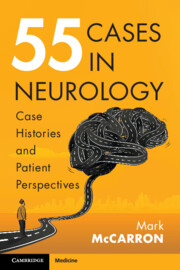Book contents
- 55 Cases in Neurology
- 55 Cases in Neurology
- Copyright page
- Contents
- Preface
- Acknowledgements
- Section 1 Visual Disturbance
- Section 2 Headache and Pain
- Case 10 Losing Volume
- Case 11 Where Is the Pus?
- Case 12 Recurrent Acute Headaches
- Case 13 A ‘Never’ Recurring Event
- Case 14 Headache and Fever
- Case 15 Brain Infection
- Case 16 Headache and Droopy Eye
- Case 17 Facial Somatic Mosaicism
- Case 18 An Alarm Clock Headache
- Section 3 Weakness
- Section 4 Behavioural and Language Changes
- Section 5 Confusion
- Section 6 Movement Disturbances
- Section 7 Acute Onset of Neurological Symptoms
- Index
- Plate Section (PDF Only)
- References
Case 13 - A ‘Never’ Recurring Event
from Section 2 - Headache and Pain
Published online by Cambridge University Press: 27 July 2023
- 55 Cases in Neurology
- 55 Cases in Neurology
- Copyright page
- Contents
- Preface
- Acknowledgements
- Section 1 Visual Disturbance
- Section 2 Headache and Pain
- Case 10 Losing Volume
- Case 11 Where Is the Pus?
- Case 12 Recurrent Acute Headaches
- Case 13 A ‘Never’ Recurring Event
- Case 14 Headache and Fever
- Case 15 Brain Infection
- Case 16 Headache and Droopy Eye
- Case 17 Facial Somatic Mosaicism
- Case 18 An Alarm Clock Headache
- Section 3 Weakness
- Section 4 Behavioural and Language Changes
- Section 5 Confusion
- Section 6 Movement Disturbances
- Section 7 Acute Onset of Neurological Symptoms
- Index
- Plate Section (PDF Only)
- References
Summary
While a passenger in a car, a 50-year-old woman experienced a sudden severe headache. The headache peaked instantaneously. She was very nauseated and started to shake. She did not lose consciousness. An ambulance was called and she was taken to a local hospital. Because of hospital-bed scarcity and/or because she usually resided in another trust, arrangements were made to transfer her to her local hospital; no neuroimaging was performed at the first hospital.
- Type
- Chapter
- Information
- 55 Cases in NeurologyCase Histories and Patient Perspectives, pp. 85 - 90Publisher: Cambridge University PressPrint publication year: 2023



